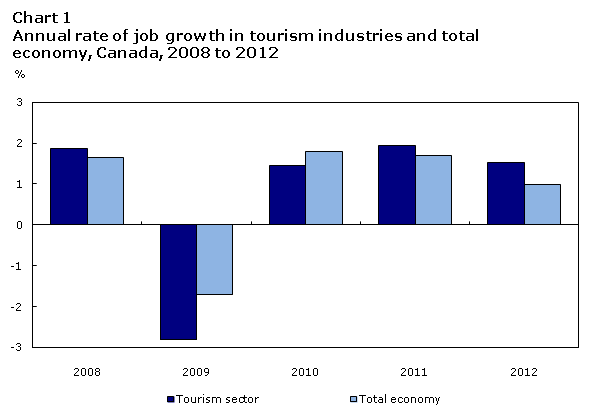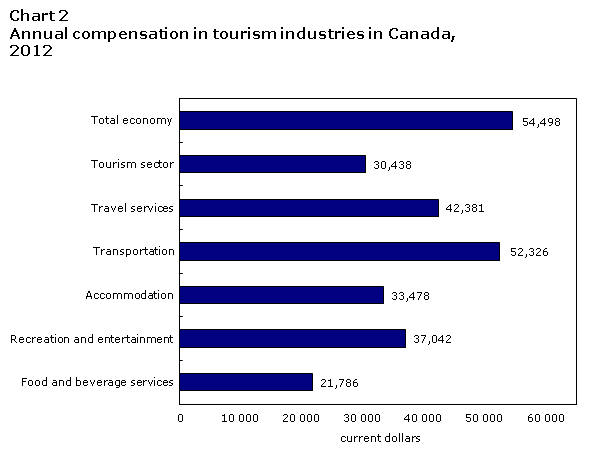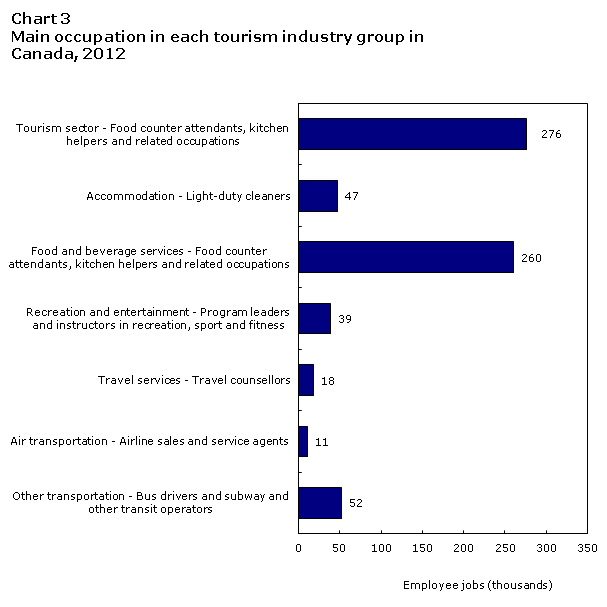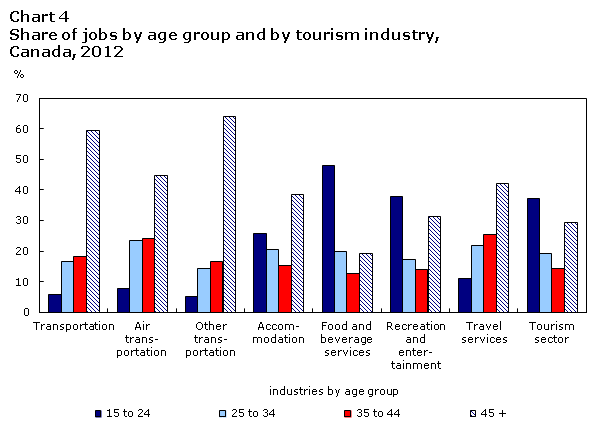Publications
Income and Expenditure Accounts Technical Series
Human Resource Module of the Tourism Satellite Account, 2012
Results
Archived Content
Information identified as archived is provided for reference, research or recordkeeping purposes. It is not subject to the Government of Canada Web Standards and has not been altered or updated since it was archived. Please "contact us" to request a format other than those available.
This section highlights some of the findings and illustrates some of the types of analyses the HRM can support. The analysis will focus on the year 2012 and on comparisons with preceding years.
5.1 Tourism sector
This section aims to compare key variables of the HRM: jobs, hours worked and compensation for the tourism sector in Canada with the overall economy over time.
Compensation for all jobs
CompensationNote 1 reached $51.3 billion in 2012 for tourism industries, up 3.7% from the previous year, compared to 4.0% for the total economy (see Table 2). This growth was due to increases in hours worked per week (+1.0%), in the number of jobs (+1.5%), and in hourly compensation (+1.1%). The tourism sector accounted for 5.3% of compensation for all jobs in 2012 (see Table 2).
Jobs
In 2012, tourism industries accounted for 1.7 million jobs. Jobs include both full- and part-time jobs, as well as jobs from self-employment. The tourism sector accounted for 9.4% of all jobs in 2012.
The number of jobs in tourism industries grew at a faster pace (+1.5%) than the number of jobs in the total economy (+1.0%) in 2012, driven mainly by full-time employment in food and beverage services. Growth in tourism jobs also outpaced growth at the total economy level in 2011, though by a smaller margin (1.9% compared to 1.7%).
In the three years since the economic downturn, the tourism sector has grown faster than the total economy (5.0% cumulative growth versus 4.6%), mainly due to the strong growth in the tourism sector in 2012.
In 2012, all of the growth in jobs in the tourism sector was in full-time employee jobs (+33,000).

It should be noted that the estimate of jobs in the HRM is greater than that in the CTSA and the NTI. The HRM concept includes all jobs in tourism industries (1.7 million), whereas the NTI and CTSA concept includes only ‘tourism jobs’ in tourism industries (that is, jobs in tourism industries attributable to visitor consumption).Note 2
Jobs attributable to visitor spending in tourism industries totalled 496,000 in 2012, up 1.4% from the previous year.Note 3
Part-time jobs (664,000 jobs) made up 39.4% of all jobs in tourism industries. By comparison, part-time jobs made up 22.4% of all jobs in Canada. In 2012, the share of part-time employment in the tourism sector fell for the first time since 2007.
Self-employment was less common in tourism, accounting for 6.2% of jobs in 2012, compared to 9.0% economy-wide. The number of self-employed in tourism fell by 2.6% when compared to the previous year. Only air transportation and travel services experienced growth in self-employment.
Hours worked per job
The average work week in the tourism sector is shorter than in the rest of the economy. Jobs in tourism averaged 29.1 hours per week in 2012, up 1.0% from the previous year, compared to 32.9 hours for jobs economy-wide (see Table 4). The shorter week in tourism reflects the higher proportion of part-time jobs found in tourism industries than in the total economy.
On the other hand, jobs from self-employment in tourism involved longer working hours (33.7 hours per week) than jobs from self-employment economy-wide (31.6 hours per week).
Compensation per job
Hourly compensation in tourism averaged $20.10 per hour in 2012, up 1.1% from the previous year (see Table 2), but much lower than the hourly compensation economy-wide of $31.86. The gap between hourly compensation in tourism industries versus the total economy reached $11.76 in 2012.
In 2012, hourly compensation for full-time workers in tourism was $21.30, while part-time workers received $15.62.
5.2 Tourism industry profiles
The HRM contains aggregated data for five tourism industry groups: transportation (with details for air transportation and other transportation reported separately), accommodation, food and beverage services, recreation and entertainment and travel services. Appendix E lists the industries included in each industry group of the tourism sector. The following provides selected results intended to give an indication of the kinds of industry analyses possible with the HRM.
Food and beverage services
Among the tourism industry groups, the food and beverage services industry group was the largest employer in 2012. This industry group accounted for 54.2% of all jobs in tourism industries in Canada with 915,000 jobs (see Table 3). In 2012, the number of jobs in food and beverage services increased by 20,000, as falling part-time employment (-0.5%) was more than offset by an increase in full-time employment (+4.9%).
Food and beverage services nonetheless held the highest share of part-time jobs (47.2%) among tourism industries. Not surprisingly, the work week in this industry, at 27.3 hours, was the shortest among all tourism industries and was well below the average work week of 32.9 hours economy-wide (see Table 4).
In 2012, the self-employed held 20,820 jobs in food and beverage services, accounting for 20.0% of all self-employed jobs in the tourism sector. They worked long hours, 40.3 hours per week on average, well above the self-employed average of 33.7 hours per week in the tourism sector.
Jobs in food and beverage services continued to pay the least of all tourism industries, with an average hourly compensation of $15.36 in 2012 (see Table 2), up 0.5% from the previous year.Note 4 It remained well below the average of $20.10 for tourism industries.Note 5
It should be noted that the average hourly wage for all employee jobs in food and beverage services was $14.01 in 2012 (see Table 5). This is $1.35 less than the average hourly compensation ($15.36), which includes supplementary labour income (employer contributions on behalf of employees to employment insurance, private and public pension plans, worker’s compensation, health and life insurance plans and retirement allowances).
Annual compensation reflects both hourly compensation and hours worked. In food and beverage services industries, jobs paid $21,786 on average in 2012 (see Chart 2). This was well below the tourism sector average of $30,438 but above the 2011 food and beverage services average of $21,309, due to the increases in weekly hours worked and hourly compensation. Jobs in food and beverage services involved the fewest working hours per week and were paid the least on an hourly basis in the tourism sector.

Recreation and entertainment
The recreation and entertainment industry group was the second-largest employer among the tourism industries, providing 275,000 jobs or 16.3% of employment in the sector. This industry group registered job losses of 0.4% in 2012.
The large proportion (42.5%) of part-time jobs in recreation and entertainment contributed to a short work week. Averaging 28.3 hours, it was the second-shortest among tourism industries.
Recreation and entertainment held the largest proportion (46.9%) of the self-employed jobs in tourism industries, with 48,825 jobs. However, these jobs involved shorter hours (27.1 hours per week) than self-employed jobs in the tourism sector overall (33.7 hours per week).
Hourly compensation in this industry ($25.16) was above the tourism sector average ($20.10), but remained below hourly compensation economy-wide ($31.86). Annual compensation reached $37,042 in 2012, above the tourism sector average, even though the work week was among the shortest in the sector.
Accommodation
The accommodation industry provided 230,000 jobs in 2012, or 13.6% of jobs in the tourism sector, making it the third-largest employer among tourism industries in Canada. The accommodation industry group registered its third consecutive annual increase in employment, with growth of 0.5% in 2012.
The industry added 1,000 jobs as a decrease in part-time employment (-6.0%) was offset by an increase in full-time employment (+2.9%). Hours worked per week in accommodation edged up to 31.9 hours in 2012, which was above the tourism sector average of 29.1 hours per week.
The proportion of part-time jobs (25.9%) in this industry group, while higher than economy-wide (22.4%), remained below the sector average of 39.4%. This industry’s share of self-employed jobs (6.1%) was among the lowest in the tourism sector. The number of self-employed jobs in accommodation continued to decline, falling to 6,380 jobs in 2012, 13.6% fewer than the previous year.
Hourly compensation in accommodation, which includes gratuities, rose 2.6% in 2012 to $20.19, just above the tourism sector average of $20.10. Annual compensation in this industry group, at $33,478, was higher than the sector average, largely due to the longer work week.
Transportation
The transportation industry group consists of air transportation and other transportation, including rail, water and bus transportation, as well as taxis and car rentals. This industry group provided 222,000 jobs, or 13.2% of all jobs in tourism. Jobs in transportation industries were up 2.6% in 2012. Air transportation added three thousand jobs while other transportation industries added two thousand. Most jobs added in air transportation were full-time jobs, whereas most jobs added in other transportation industries were part-time jobs.
Jobs in transportation came with a long work week: on average 33.7 hours, over four hours longer than the average for all jobs in tourism. One reason for the longer hours was the higher proportion of full-time jobs (77.7%), particularly in other transportation industries. Another reason was the relatively high proportion (10.9%) of self-employed workers in transportation industries, who work longer hours. For the tourism sector as a whole, the self-employed made up only 6.2% of jobs. Transportation supported 24,255 jobs from self-employment, 23.3% of all jobs from self-employment in the sector, of which almost all were in the other transportation industries.
In addition to the second-longest work week, jobs in transportation were paid more than in other tourism industries, with an hourly compensation of $29.88, well above the average across all jobs in the sector. Hourly compensation was particularly high in air transportation, at $39.48 per hour.
Transportation is the only industry group in the tourism sector with an annual compensation ($52,326) approaching the national average of $54,498. The long work week and the high hourly compensation in both air and other transportation contributed.
Travel services
The travel services industry group is the smallest among all tourism industries. Travel services provided 44,000 jobs in 2012, just 2.6% of all jobs in tourism in Canada. It trailed the sector in terms of job growth with a loss of 1.5% in 2012.
Jobs in this industry group were predominantly full-time (84.7%), the highest proportion among all tourism industries. Not surprisingly, this industry group had the longest work week, at 35.3 hours. Over 3,700 workers were self-employed, 8.5% of all jobs in travel services.
Annual compensation was among the highest in the tourism sector, at $42,381, owing to the high proportion of full-time jobs and above-average hourly compensation.
5.3 Occupations in tourism industries
Five occupation groups dominated the tourism sector in terms of employee jobs: food-counter attendants, kitchen helpers and related occupations with 276,000 jobs, of which almost all (260,000) were in the food and beverage services industry group; food and beverage servers with 188,000 jobs; cooks with 150,000 jobs; cashiers with 71,000 jobs; and restaurant and food service managers with 67,000 jobs. Furthermore, these same five occupations also dominated the food and beverage services industry.
The most prevalent occupation in air transportation was airline sales and service agents, with 11,000 jobs (see Chart 3). Bus drivers and subway and other transit operators were the main occupation group in other transportation industries, with 52,000 jobs. The main occupation in the accommodation industry group was light duty cleaners, with 47,000 employee jobs, while program leaders and instructors in recreation, sport and fitness were the most common occupation in recreation and entertainment, with 39,000 jobs. Travel counsellors accounted for only 18,000 jobs, but represented the primary occupation in travel services.
When comparing wages for the most prevalent occupations by tourism industry, airline sales and service agents ($22.57), bus drivers and subway and other transit operators ($22.39), and program leaders and instructors in recreation, sport and fitness ($19.68) earned more than the tourism sector average wage of $17.97. On the other hand, travel counsellors ($17.91), light duty cleaners ($14.90) and food counter attendants, kitchen helpers and related occupations ($12.16) earned less than the tourism sector average.

5.4 Profile of employees in tourism industries
The HRM provides details concerning three characteristics of employees: sex, age group, and immigrant status. The following highlights some of the HRM results according to these demographics (see Table 5).
Sex
Women working in the tourism sector accounted for 54.6% of employee jobs in 2012. This share has declined from 55.9% in 2005.
Women held 864,000 employee jobs in the tourism sector in 2012, 145,000 more than men. A higher proportion of women working in tourism industries were less than 25 years of age (39.2%) compared to men (34.9%).
Women were outnumbered by men in the transportation industry group. Only 30.1% of the employee jobs in this industry were held by women. On the other hand, women held the majority of jobs in travel services (73.0%).
In all tourism industries, women had shorter work weeks than their male counterparts. This was especially the case for air transportation (27.3 hours per week for women compared to 35.7 hours for men) and other transportation industries. Women (43.9%) were also more likely than men (34.2%) to work in part-time jobs.
Women working in tourism industries in Canada earned on average $4.25 per hour less than men ($15.86 per hour versus $20.11). There was a noteworthy variation in women’s wages, with jobs in air transportation paying the most, $27.45, and jobs in food and beverage services paying the least ($13.36). Even though women in air transportation jobs were well-paid, they were still paid $8.95 less than men on average.
The majority of women employed in the tourism sector worked in food and beverage services industries (61.4%), where wages paid to women were the lowest, $13.36 per hour, and the number of hours worked were the lowest, 25.3 hours per week. By comparison, 50.6% of men employed in the sector were in this industry, and were paid $14.82 per hour on average.
The most common occupation was the same for women as for men, namely, food and counter attendants and kitchen helpers and related occupations. However, this occupation accounted for a greater share of employee jobs held by women (19.3%) than of those held by men (15.1%).
In 2012, women earned an average annual salary of $21,948 in the tourism sector compared to $32,931 for men. This difference stemmed from the lower hourly wages for women and the shorter work week.
Youth and older workers
Youth aged 15 to 24 years were a major source of labour for the tourism industries in Canada in 2012. They held 589,000 employee jobs, accounting for more than a third of all employee jobs in tourism. Three out of four young workers were employed in the food and beverage services industries. The most common occupation among youth was food counter attendants, kitchen helpers and related occupations, and two of every three such jobs were held by a young worker.

Older workers, those aged 45 years and over, were also an important source of labour for tourism, holding 463,000 employee jobs (29.2%). In 2012, older workers were employed more evenly across all tourism industries compared to young adults. One tourism industry group employed a notably older workforce: older workers accounted for 64.1% of all jobs in transportation industries other than air. By comparison, the next oldest workforce was that of air transportation, with 44.6% of all jobs held by persons aged 45 years or older (see Chart 4).
Almost seven out of ten young workers in tourism held part-time jobs compared to about one out of four older workers. The vast majority of young adults who worked part-time were employed in the food and beverage services industry. Young adults worked about half the hours per week (17.7 hours) of older workers (35.0 hours). The discrepancy was greatest in the recreation and entertainment industries (15.0 hours for young adults versus 34.6 hours for older workers).Note 6
Wages of young workers were also considerably lower. The hourly wage among workers in tourism industries aged 15 to 24 was $12.10 in 2012, just over half that of employees aged 45 and over ($21.83). The wage differential between young and old workers was the most pronounced in the air transportation industry group, $15.52 versus $40.00, respectively.
Immigrants
Immigrants were another important source of labour for the tourism sector. In 2012, immigrants held 354 thousand jobs, accounting for 22.4% of employee jobs in tourism.
Over sixty percent of all immigrants employed in the sector worked in the food and beverage services industry, compared to 55.4% of non-immigrants. On the other hand, only 8.4% of all immigrants employed in the sector worked in recreation and entertainment compared to 16.0% of non-immigrants. The concentrations were similar between immigrants and non-immigrants in other tourism industry groups.
Immigrants in tourism industries were older than other tourism workers. About four out of ten immigrants were 45 years or older, while one out of four non-immigrants was an older worker.
Compared to non-immigrants (57.5%), immigrants (70.9%) were more likely to work full-time. In 2012, immigrants worked longer hours than their non-immigrant counterparts, 33.8 hours per week versus 27.4 hours.
Immigrants earned lower wages per hour ($17.31 per hour) than non-immigrants ($18.21 per hour). Wages for immigrants were lower in all tourism industries with the exception of accommodation and recreation and entertainment.
Even though immigrants earned lower wages per hour on average, they compensated by working longer hours. Annual salaries for immigrants averaged $30,400, compared to $25,936 for non-immigrants.
Notes
- Compensation is defined as wages and salaries, supplementary labour income and the labour portion of income after expenses accruing to the self-employed.
- For more information, see Appendix B: Concepts and definitions.
- See Statistics Canada 2013b.
- This statistic is based on compensation in employee jobs and jobs from self-employment
- Gratuities are included in these figures. See Appendix C to understand how gratuities are calculated.
- According to the Labour Force Survey, in 2012 about 72% of young workers gave attending school as their main reason to be working part-time. Source: Statistics Canada. Table 282-0014 – Labour force survey estimates (LFS), part-time employment by reason for part-time work, sex and age group, annual (persons), CANSIM.
- Date modified:
